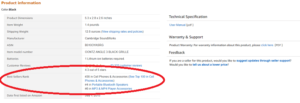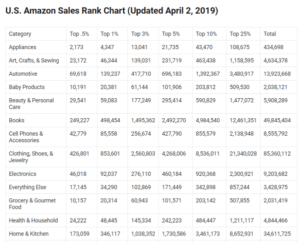Experienced sellers on Amazon know that there are several factors that influence each and every product’s pricing, fulfillment strategies, and overall popularity. The platform is one of the largest and most influential in the world (there are currently over 100 million Amazon Prime members globally), which means big opportunities for sellers who know how to use the complex system to their advantage.
Today, we are going to take a dive into one of the most misunderstood and often-overlooked factors that affects nearly all of Amazon sellers – Amazon Sales Rank. Even novice sellers know that a sky-high sales rank can curse a great product and make the algorithm work against them in some way, but that doesn’t mean that they understand how it influences the bigger picture. Let’s take a look at the basics of Amazon Sales Rank, and how you, as a seller, can ensure that your products are always front-and-center and that your profits are always maximized.
Definition of Amazon Sales Rank
Just as its name suggests, Amazon Sales Rank, also known as Best Seller Rank (BSR), is the position at which a product is currently placed, according to the corresponding criteria illustrated in the Amazon A9 algorithm. While other criteria deal with SEO, such as keywords, or customer feedback, Amazon Sales Rank captures only the sales history of a listed item within its category, which is designated by the seller.
The Amazon Sales Rank can be found on a product’s page, in the ‘Product information’ section. Depending upon the market, it can also be seen listed as the ‘Best Sellers Rank’. If the product that you are viewing has pages and pages of competitors, the Sales Rank number might be very high (it can go up to 1 million+). That said, sellers do not want to aim for having a high number; the lower the Sales Rank number, the better positioned it is for achieving ‘best-seller’ status.

Screenshot via Amazon
In the screenshot above, we can see that the OontZ Angle 3 Bluetooth Portable Speaker ranks:
- 36th in Cell Phones & Accessories
- 4th in Portable Bluetooth Speakers
- 6th in MP3 & MP4 Player Accessories
In this example, it’s easy to see the benefit of having a product listed in several categories: It gives you a chance to rank higher in some results, depending on how competitive each category is. In turn, that helps you drive more traffic to your product listing pages. If you’re using Amazon advertising, such as Amazon Sponsored Products, increased traffic can also contribute to the flywheel effect.
The Ins and Outs of Amazon Sales Rank
One of the things that surprises new sellers about Amazon Sales Rank is that, no matter how steady the sales may be, the rank for any given product might change dramatically – and will always change continuously. You see, Amazon has its systems set so that ranks are assessed hourly, with the numbers reflecting the most up-to-date information on products’ popularity. Unsurprisingly this can cause a lot of confusion for the uninitiated.
For example, if a seller has just released a new coffee machine in the ‘Appliances’ category, its Sales Rank might drop sharply directly after a blast promotion. It could take the appliance from a quadruple-digit position down to a double-digit in the matter of an afternoon. That said, when the seller checks its ranking the next morning, it may be higher than it was just 24 hours prior.
This style of tracking system might seem as though it is designed with the sole purpose of stressing out a seller, but the system is actually much simpler than that. In a nutshell, Amazon Sales Rank is simply the period of time between two sales within an hourly period (historical data also comes into play, which is a bit more difficult to unpack). Ideally, you will want the window of time between sales to be as short as possible, thus granting your product a higher rank and more exposure.
Tips on Boosting Your Amazon Sales Rank
Just like many of the other Amazon selling tips out there, boosting sales rank has everything to do with continued education on the part of the seller. The first thing that you should do is take a look at each product individually, by category, and then, by Sales Rank. Remember, Amazon Sales Ranks differ greatly depending on the category – so if you have a product that has a better selling history than another, with a higher rank, that likely isn’t an error.

Screenshot via CleartheShelf.com
Considering this in real-world figures, on April 2, 2019, there were 2,173 products in the top 0.5% of the ‘Appliances’ category, yet there were 95,583 products in the top 0.5% of the ‘Sports and Outdoors’ category. This means that the afore-mentioned coffee machine’s rank and competition will differ significantly from that of a toy football.
After you have spent time holding your Sales Rank numbers against the current charts, schedule times to analyze these numbers as they update, so that you can gather historical data. As mentioned, the ranks will differ tremendously depending upon how wide of a window your sales are, but this semi-regular exercise will help you build a better sense of what might be affecting your overall bottom line, aside from customer feedback, product descriptions, SEO, etc.
All of that said, strong content and advertising will always serve as the building blocks for your visibility on Amazon. Assessing Sales Rank is a fitting way to see how your product is performing against the competition over time, but it should not be treated as a part of your selling strategy. Instead, spend your time developing a great product that people want to use, implementing best practices to increase your listings’ conversion rates, and developing a smart Amazon advertising strategy.





